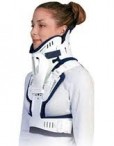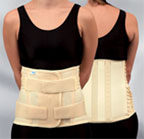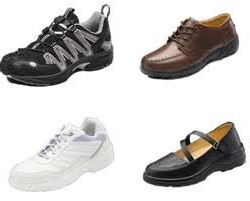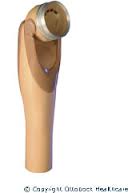31 Oct Types of Orthoses & Prostheses
An orthosis can be defined as: An external orthopedic appliance, either prefabricated or custom made, that controls movement of specific body parts. Your health care provider’s evaluation directs us to the specific type of control needed for your orthotic care.
Working with your doctor and family, we develop a treatment plan and follow up with one goal: to help you return to your daily routine as soon as possible.
Click on the following types of Orthoses / Prostheses to learn more:
- Cervical Orthosis
- Cervical Thoracic Orthosis (CTOs)
- Spine Orthotic
- Arm
- Wrist/Hand
- Hips
- Knee Orthosis (KO) Brace
- Ankle Foot Orthoses (AFO)
- Foot Orthotic
- Diabetic Shoes and Inserts
- Prosthetics
- Upper Limb
Cervical Orthosis
Cervical Orthosis (COs) support the occiput and chin in order to decrease range of motion from C-2 to C-5. CO’s generally are used to support stable spine conditions.[/threecol_two][threecol_one_last]
back to top
[hr]
[threecol_two]
Cervical Thoracic Orthosis (CTOs)
Cervical-thoracic orthosis (CTOs) provide greater motion restriction from C-5 to C-7 spine from the increased leverage on the person’s body. The upper cervical spine has less motion restriction. CTOs are used in minimally unstable fractures. All CTO’s tend to control flexion better than extension.[/threecol_two] [threecol_one_last]
back to top
[hr]
[threecol_two]
Spine Orthotic
A spinal orthotic device (commonly referred to simply as an orthotic or an orthosis) is an external apparatus that is applied to the body to limit the motion of, correct deformity in, reduce axial loading on, or improve the function of a particular spinal segment of the body.[/threecol_two] [threecol_one_last]
back to top
[hr]
[threecol_two]
Arm
Upper-limb (extremity) orthoses are devices applied externally to restore or improve functional and structural characteristics of the musculoskeletal and nervous systems. In general, musculoskeletal problems include those resulting from trauma, sports, and work-related injuries.
Static orthoses – As the term implies, these devices do not allow motion. They provide rigid support for fractures, inflammatory conditions of tendons and soft tissue, and nerve injuries
Dynamic/functional orthoses – In contrast to static orthoses these devices permit motion, on which their effectiveness depends. These types of upper-extremity orthoses are used primarily to assist movement of weak muscles. Some dynamic splints have a dual or bilateral mechanism for providing tension, safely accommodating moments of spasm and thus limiting soft-tissue injuries.[/threecol_two] [threecol_one_last]
[/threecol_one_last]
back to top
[hr]
[threecol_two]
Wrist/Hand
Definition: an orthosis that begins at the fingers, crosses the wrist, and terminates on the distal portion of the forearm; used to provide grasp and release despite some degree of hand paralysis.
[/threecol_two] [threecol_one_last]
back to top
[hr]
[threecol_two]
Hips
Postoperative total hip orthoses sometimes are used after a total hip replacement in order to prevent the motions of hip flexion, adduction and internal rotation that can cause dislocation. In infants with developmental dysplasia of the hip, which causes hip instability, a Pavlik harness or hip abduction orthosis is used to position hips in flexion and abduction to encourage desired bone development and prevent dislocation. Hip abduction orthoses are also used to treat children with Legg-Calve-Perthes disease.
[/threecol_two] [threecol_one_last]
[/threecol_one_last]
back to top
[hr]
[threecol_two]
Knee Orthosis (KO) Brace
A knee orthosis (KO) is a brace worn to strengthen the knee. This brace is worn around the knee and works by relieving pressure off the part of the knee joint that is affected by ailments such as arthritis or osteoarthritis. They can also offer support for the knee and provide the stability needed to perform daily activities.[/threecol_two] [threecol_one_last][/threecol_one_last]
back to top
[hr]
[threecol_two]
Ankle Foot Orthosis (AFO)
Ankle Foot Orthosis (AFO) refers to a variety of protective external devices that can be applied to the ankle area to prevent injury in a high-risk athletic activity, to protect a previous injury such as a sprain, or to assist patients with chronic joint instability with walking. An AFO is often used by patients unable to dorsiflex the ankle during gait. It may be used to maintain anatomic position in a person that has a footdrop.[/threecol_two] [threecol_one_last]
[/threecol_one_last]
back to top
[hr]
[threecol_two]
Foot Orthotic
A prescription foot orthosis, or foot orthotic, is ordered for a misshapen or deformed foot as well as to help relieve areas of pressure on the foot. It is designed to support the foot by applying pressure to areas to encourage an appropriate gait. Orthoses may be made of a wide range of materials such as firm plastics or semi-rigid material such as crepe, laminate or composite or various density foams. They can be either full or three-quarter length.[/threecol_two] [threecol_one_last]
[/threecol_one_last]
back to top
[hr]
[threecol_two]
Diabetic Shoes and Custom Shoe Inserts
Medicare recognizes the importance of proper footwear for diabetics and coverage is available for diabetics on Medicare who suffer from certain complications affecting the foot. Qualifying complications include neuropathy, calluses, poor circulation and a history of ulceration. Other complications may also qualify.[/threecol_two] [threecol_one_last]
back to top
[hr]
[threecol_two]
Prosthetics
Lower Extremity Prosthetics describes artificially replaced limbs located at the hip level or lower. The two main subcategories of lower extremity prosthetic devices are 1. trans-tibial (any amputation transecting the tibia bone or a congenital anomaly resulting in a tibial deficiency) and 2. trans-femoral (any amputation transecting the femur bone or a congenital anomaly resulting in a femoral deficiency). In the prosthetic industry a trans-tibial prosthetic leg is often referred to as a “BK” or below-the-knee prosthesis while the trans-femoral prosthetic leg is often referred to as an “AK” or above-the-knee prosthesis.
Prosthetic devices act as a replacement for either an entire limb or just part of that limb, whether it be an arm or leg. A prosthesis is used to provide a person with the opportunity to perform functional tasks, particularity ambulation (walking), which may not be possible without the limb.
Amputation surgery most often is performed due to complications of peripheral vascular disease or neuropathy; trauma is the second leading cause of amputation. Amputations performed because of tumor or congenital limb deficiencies are less common.[/threecol_two] [threecol_one_last]
[/threecol_one_last]
back to top
[hr]
[threecol_two]
Upper Limb
Patients use upper limb prostheses for two general purposes; to improve their appearance and to increase their ability to perform tasks. Unfortunately, these two purposes often conflict with one another. Prostheses that look like normal hands are often limited in their functionality, while highly functional devices may look unattractive. Many patients use two different prostheses; one for situations in which appearance in most important, and another for situations in which adequate function is desired.[/threecol_two] [threecol_one_last]
back to top






Sorry, the comment form is closed at this time.